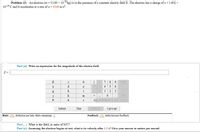Question

Transcribed Image Text:Problem 13: An electron (m = 9.109 x 103'kg) is in the presence of a constant electric field E. The electron has a charge of e = 1.602 x
10-19 C and it accelerates at a rate of a = 8100 m/s?.
Part (a) Write an expression for the magnitude of the electric field.
E =
7
8
HOME
a
d
e
4
5
g
h
i
1
2
3
j
k
END
m
S
VO BACKSPACE
DEL CLEAR
Submit
Hint
Feedback
I give up!
Hints: 0% deduction per hint. Hints remaining: 2
Feedback: 1% deduction per feedback.
Part) What is the field, in units of N/C?
Part (c) Assuming the electron begins at rest, what is its velocity after 2.5 s? Give your answer in meters per second.
Expert Solution
This question has been solved!
Explore an expertly crafted, step-by-step solution for a thorough understanding of key concepts.
This is a popular solution
Trending nowThis is a popular solution!
Step by stepSolved in 3 steps

Knowledge Booster
Similar questions
- An electron is accelerated eastward at 2.28 × 109 m/s2 by an electric field. Determine the magnitude of the electric field.arrow_forwardTo study the properties of various particles, you can accelerate the particles with electric fields. A positron is a particle with the same mass as an electron but the opposite charge (+e). If a positron is accelerated by a constant electric field of magnitude 271 N/C, find the following. (a) Find the acceleration of the positron. m/s² (b) Find the positron's speed after 6.50 x 10-9 s. Assume that the positron started from rest. m/sarrow_forwardInside a cathode ray tube, an electron is in the presence of a uniform electric field with a magnitude of 275 N/C. (a) What is the magnitude of the acceleration of the electron (in m/s2)? m/s2 (b) The electron is initially at rest. What is its speed (in m/s) after 1.20 ✕ 10−8 s? m/sarrow_forward
- Three charges are placed along the x-axis: q1 = 3.00 µC at X1 = -20.0 cm, q2 = -5.00 µC at x2 = 10.0 cm, and q3 = 6.00 µC at x3 = 25.00 cm. Determine the magnitude of the electric field at the origin. O 4 69x106 N/C O 2 96x106 N/C O 6 04x106 N/C O 4.31x106 N/Carrow_forwardOn a typical clear day, the atmospheric electric field points downward and has a magnitude of approximately 110 N/C. Compare the gravitational and electric forces on a small dust particle of mass 3,1 x 10 g that carries a single electron charge. 1.1134 What is the acceleration (both magnitude and direction) of the dust particle? (Enter the magnitude in m/s.) magnitude m/s direction downward varrow_forwardphyarrow_forward
- Q1arrow_forwardFour electric charges are placed on corners of a square of side 8 cm. Determine the magnitude and direction of the force acting on -4 μC charge. Find the magnitude and direction of the electric field at the origin.arrow_forwardA proton is projected in the positive x direction into a region of uniform electric field E = (-6.20 × 105) ↑ N/C at t = 0. The proton travels 7.90 cm as it comes to rest. (a) Determine the acceleration of the proton. m/s² magnitude direction -X (b) Determine the initial speed of the proton. m/s magnitude direction +X ✓ ✓ (c) Determine the time interval over which the proton comes to rest.arrow_forward
- Two protons are separated by a distance of 0.366 m. Given the proton charge of 1.60 x 10-19 c, determine the magnitude of the electric force that one proton exerts on the other.arrow_forward(a) Two protons in a molecule are 4.40 × 10 -10 m apart. Find the electric force exerted by one proton on the other. magnitude What is the equation for the electrical force acting between two charged objects? N direction repulsive (b) State how the magnitude of this force compares with the magnitude of the gravitational force exerted by one proton on the other. Fe %D F. What is the mass of a proton? (c) What must be a particle's charge-to-mass ratio if the magnitude of the gravitational force between two of these particles is equal to the magnitude of electric force between them? С/kgarrow_forward
arrow_back_ios
arrow_forward_ios